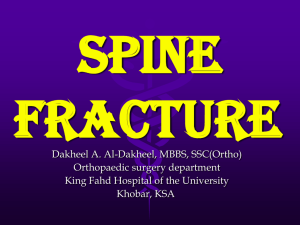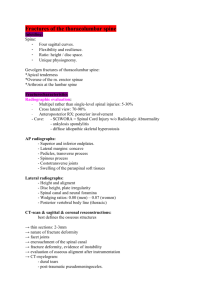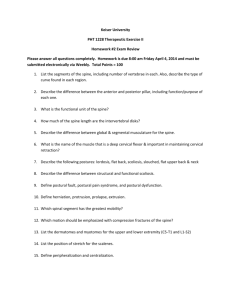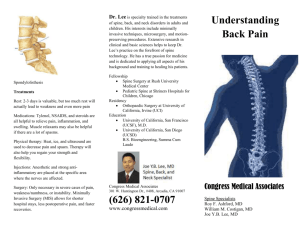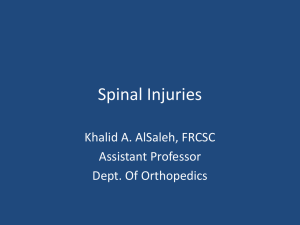Burst Fractures
advertisement
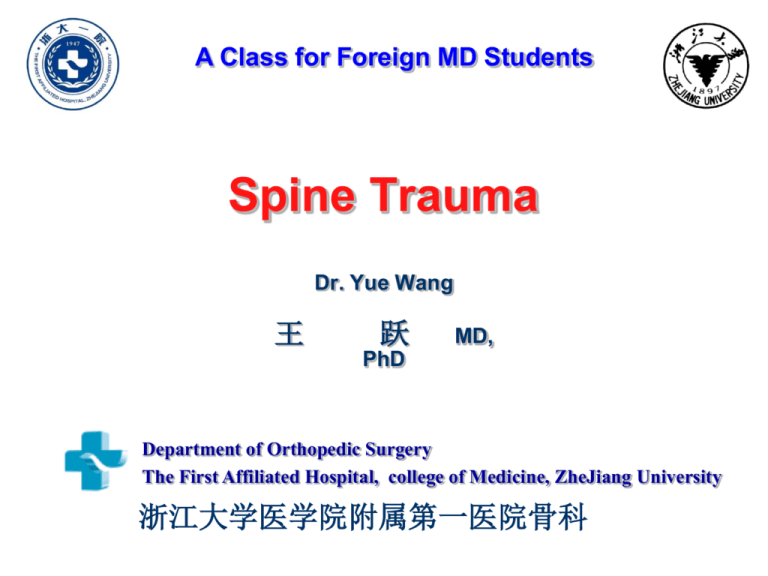
A Class for Foreign MD Students Spine Trauma Dr. Yue Wang 王 跃 MD, PhD Department of Orthopedic Surgery The First Affiliated Hospital, college of Medicine, ZheJiang University 浙江大学医学院附属第一医院骨科 Anatomy of the Spine Cervical spine, C, Thoracic Spine, T, 12 Lumbar Spine, L, 5 Sacrum, S, 5, fused Coccyx, 3-4, fused AP and Lateral View Osteology: The Vertebra The shape of the vertebrae changes! C T L The Cervical vertebrae atlas, C1 C3-7 axis, C2 The lumbar spine The thoracic and lumbar vertebrae Articular processes Pars Superior Articular Process Pars interarticularis Zygapophyseal Joint (Facet Joint) Inferior Articular Process Arthrology Intervertebral Discs Fibrocartilaginous joint Increase in size from C to L Ratio remains the same Make up 20-30% of length of column The intervertebral disc Two components: nucleus and anulus fibrosus Major Ligaments of the Spine Anterior Longitudinal Ligament - ALL Dense band along anterior and lateral surface of the vertebral bodies from C2 to sacrum Posterior Longitudinal Ligament – PLL Runs along posterior surface of vertebral bodies (anterior to spinal canal) Ligamentum flavum Supraspinous lig. and interspinous lig. Ligaments Ligaments of the spine Spinal Cord Part of the CNS along with brain Contained within vertebral canal Extends from cranium to 1st-2nd lumbar vertebrae Lumbar roots & sacral nerves for a “horse-like tail” called cauda equina 2 plexuses Brachial, lumbosacral Nerves Each vertebrae has a nerve that exits either below or above it 31 pairs of spinal nerves 8 cervical nerves 12 thoracic nerves 5 lumbar 5 sacral 1 coccygeal The thoracic spine Spinal Injuries Suspected spinal injuries High speed crash: MVA Unconscious Multiple injuries Neurologic Spinal deficit pain/tenderness Spinal injury • 5% worsen neurologically at hospital • Protection is a priority • Detection is a secondary priority • Spinal evaluation complicated by multiple traumae; Mechanism of Injury Axial compression: Compress/crush the C spine; tends to fracture the vertebra into pieces Distraction Pull apart the spinal elements Usually associated with flexion or extension forces Mechanism of Injury Mechanism of Injury Flexion: Severe forward bending In cervical spine, often leads to neurological damage Extension: Severe backward bending Not always associated with neurological trauma Mechanism of Injury Mechanism of Injury Shear: Mechanism of Injury Rotational Rescue Save the life: ABC; Evaluate/identify a patient with spinal injury; Using a spinal board; Determine appropriate disposition; Classification of Neurologic Injury Frankel Score A: Complete loss of motor and sensory function B: Only sensory function remains C: Motor function is present but of no practical use (i.e., can move legs but not walk) D: Motor function impaired (i.e.can walk but not with normal gait) E: No neuro impairment noted Diagnosis Spinal injury • Physical examinations; • X-ray; • CT; • MRI; • Electromyogram (EMG); C Spine Injury The C spine is involved in more than half of all the patients with traumatic spine injuries Stability is a crucial key point to determine the choice of management, and it is determined by the integrity of the anatomical structures constituting the cervical spine Lesions with spinal cord involvement are unstable One of the most common pitfalls in patients with cervical spine injury is missed or delayed diagnosis! Reasons: 1) inadequate radiographs (44%) ; 2) misinterpretation of adequate radiographs (47%) Goals of Management Decompression Alignment Stabilization Reconstruction, if necessary Adequate management starts from A proper classification of the injury type Assessment of stability of the affected segment Instability : “the loss of the ability of the spine under physiological loads to maintain relationships between vertebrae in such a way that the spinal cord or nerve roots are not damaged or irritated and deformity or pain does not develop. Stable or unstable Lesions with spinal cord involvement are severe and unstable and require surgical management. On the other hand, lesions without spinal cord involvement can evolve toward a stable or unstable lesion Lesions that mainly involve bone structures may determine temporary instability. Successful fracture healing (with bony callus formation) and subsequent stabilization of these lesions may be obtained with reduction and immobilization. On the other hand, ligamentous or osteo-ligamentous lesions may cause irreversible instability with secondary dislocation. Imaging Evaluation Alignment/Bones /Soft Tissue Look for Normal atlanto-occipital alignment Predental space 3 mm or less Prevertebral soft tissue space less than 5 mm anterior to C3 Spinal canal plain film AP diameter 13 mm or greater Any horizontal translation of one vertebra on the next Fanning of the space between spinous processes Fracture of any bone Upper C spine trauma Jefferson’s fracture Burst fracture of rings of C1 Sometimes without neurological deficit Hangman’s fracture Involves C2 Sudden hyperextension of head and neck forces vertebrae against spinal cord Complete neurological loss Radiograph Odontoid fractures Type 1 fractures at tip Type 2 fractures at waist Type 3 fractures at base MRI Lower C Spine Fractures n Facet joint dislocation May occur without fracture Possible spinal canal compromise Thoraco-lumbar fractures axial may result in anterior discoligamentous disruption and posterior compression fractures of facets, laminae, or spinous processes rotation the posterior ligamentous and osseous elements fail in tension hyperextension Axial load may result in a burst fracture flexion/distraction compression Combine compressive forces and flexion/distraction mechanisms and are highly unstable shear Shear forces produce severe ligamentous disruption and are often associated with spinal cord injury Classifications White and Panjabi defined clinical instability of the spine : Loss of the ability of the spine under physiologic loads to maintain relationships between vertebrae in such a way that there is neither damage nor subsequent irritation to the spinal cord or nerve root and, in addition, there is no development of incapacitating deformity or pain from structural changes. Denis’ 3 columns theory & Classifications minor and major injuries: minor injuries included fractures of the articular, transverse, and spinous processes as well as the pars interarticularis. Major injuries were divided into compression fractures, burst fractures, flexiondistraction (seat-belt) injuries, and fracture dislocations Wedge/compression fractures These injuries may involve both endplates(A), the superior endplate only(B), the inferior endplate only (C), or a buckling of the anterior cortex with both endplates intact (D) Burst fractures Five subgroups: type A fracture is characterized by #’s of both the superior and inferior end plates, usually as a result of an axial load. The types B and C burst fractures involve the superior and inferior end plates, respectively. result from an axial load coupled with a flexion load. An axial and a rotational load give rise to a type D burst fracture. The type E fracture is characterized by widened pedicles with a burst and lateral flexion injury. Flexion-Distraction fractures (Seat-belt/Chance Fractures) Fracture dislocations General guidance Treatment based on Denis classification Wedge most Fractures treated with external orthosis surgical indications: failure of brace progressive deformity >50% height loss >30° kyphosis Burst canal Fractures compromise & neuro deficit should be treated with surgical decompression Consider non-operative if: neuro intact kyphosis <20-30° residual spinal canal > 50% anterior body height > 50% of posterior height posterior column intact purely boney injury show stability in supine/upright x-rays in brace Seat-belt/Chance Fractures usually unstable if purely osseous injury consider trial of bracing and close serial xray f/u if ligamentous injury healing less predictable, probably best to do posterior fusion Fracture-Dislocation generally all unstable and require surgery associated with >75% neuro injury (1/2 of which are complete), dural tears, exposed/avulsed roots usually posterior fusion (early anterior fusion dangerous since associated visceral injury is common) staged anterior decompression if necessary Case 1 Post-operative surgery Case 2 Post-operative Thanks! The Rock Mountain, 2012


